| This article courtesy of Fuerman Farrier Service, Hearne,
TX
Walter Fuermann is a Certified Farrier with the American
Farrier's Association. He has a BS in Animal Science from Texas A & M
University and is a member of the Texas Professional Farrier's Assoc. and
the American Farrier's Assoc. He and his wife, Lee, also a graduate of Texas
A & M, run a full-time farrier service throughout central Texas. They do
numerous miniature horses.
What Does The Farrier Do?
The farrier's job is to take care of the feet (hooves). He does this by
regularly keeping the hooves trimmed and observing the conditions of the
hooves - do they look healthy or unthrifty? The farrier trims up the frog
for sanitary reasons, cleans out dead sole, and balances the hoof - making
it flat and level. He can also do some corrective work, depending on where
the deviation is.
Tools Of The Trade
Trimming feet does not require as many tools as shoeing and therapeutic
shoeing does. The farrier will use a rasp, a hoof pick, a hoof knife, and
nippers. The rasp is used like an emery board, the pick is used to clean the
debris out of the foot, the hoof knife is used to clean out dead sole and
the nippers are used for cutting the excess hoof wall growth off.
Parts Of The Hoof
The parts of the hoof that you will be dealing with are the hoof wall,
sole, and frog. These are the parts of the foot, which come in contact with
the ground and must be trimmed regularly to maintain proper balance and
hygiene.
Balance is a term we use to describe centering an animal's
weight evenly over the foot. Rarely do feet stay in proper balance on their
own, especially on domestic animals. To balance a foot, you use a properly
trimmed frog as a guide to look for symmetry in the foot. Horse feet are
forward of the frog so finding balance can be difficult for the untrained
eye.
Hygiene is extremely important, especially when animals are
somewhat confined and continually walking over the same ground where they
urinate and defecate. Cleaning the feet and cutting out excess hoof wall,
dead sole, and dead frog will prevent buildup of trash and help to maintain
a healthy foot, and happy feet mean happy horses!
Before you can do good work, you must have a horse that will
stand quietly while the work is being performed. We recommend that you tie
your horses occasionally and brush them all over. This will relax them and
they will get used to being touched everywhere. Also, pick the feet with a
hoof pick.
We recommend baby horses have their first foot trim between
1 and 2 months of age. Be very careful with babies as they fight a lot and
have very small feet. Very few baby horses have major feet and leg problems
when they are young, so don't get carried away with trying to straighten
them out; you will probably cause more problems than you will cure. The most
common problem youngsters have is weak Deep Flexor Tendons which cause the
foot to get in front of the leg and have a long toe. The baby will look like
it is walking on the back of the foot (the hairline). If you have this
problem, trim the heels down and back the toe up as best you can and in time
they usually grow out of this.
Common Mistakes Made By Unskilled/Untrained People
Farrier Science is very similar to ice-skating. It looks easy, anyone
can do it, until you actually jump in there. There is a lot more to trimming
and shoeing than just "hacking and whacking, and slapping some shoes on". It
requires a lot of eye-hand coordination, and knowing the anatomy of the foot
- there are very small variances. Therefore there is not much room for
error. The common problems are:
-
Taking off more on one side than the other - left or right
handed problem.
-
Leaving too much heel as they are trying to "stand" the
horse up. Hoof will get pushed out in front of leg, thus straining the
tendons. Horse people really want to see steep hooves, so we see this a
lot! This only creates pain in the heels of the horse and there is no need
for this!
-
Not taking enough toe. This is done when people are afraid
to do much, so they just rasp the bottom of the hoof. Gives the foot a
long, pointed appearance.
-
Not trimming the frog properly which makes the foot prone
to thrush and being generally unsanitary.
Hoof-Related Problems With Miniature Horses
In general, miniature horses seem to have 3 problem areas:
1. Abscesses
2. Laminitis
3. White Line Disease (WLD) this is a biggy!!
1. Abscesses - are similar to having a pimple. They
just come up all of a sudden, are very painful, are related to moisture,
usually appear on the front feet, and may or may not be seen when looking at
the bottom of the hoof. An untreated abscess can become infected causing
serious complications.
Treating abscesses consists of cleaning the hoof out with a pick, soaking
the foot in warm Epsom salt water (follow box directions) for 10-15 minutes
a day for 7-10 days. If you can see the abscess - dig it out as best you can
to allow drainage. If you cannot see where it is, keep soaking the foot
several days until the pain is completely gone - after soaking, put 7%
Iodine or Sav-A-Hoof in hole.
2. Laminitis - is caused by some sort of stress to
the system which in turn causes inflammation in the hoof, resulting in the
capillaries bursting and dying and the sensitive white line loosing its
attachments to the coffin bone. Having a fingernail being torn loose is very
similar to what is happening. The pain is intense, the horse will stand with
its front feet out in front of it and will be rocked back on its hind feet
("Founder Stance") or will not put any weight on the affected foot if only
one foot is involved. Most Laminitis is in the front feet, but it can be in
just the hind feet, one foot, or all four. Founder is when the support is
gone and coffin bone falls. Abscesses usually occur in the beginning stages
of Laminitis - in fact we have actually had pus dripping out the bottom of
the hoof on really bad cases. Miniatures don't seem to have as much pain as
standard size horses; probably due to the fact that minis are not as heavy.
The best way to deal with Laminitis is to prevent it from happening in the
first place. Keep your feed grains, dog food, and cat food, out of the reach
of horses. Be very careful of feeding cattle feeds. Cattle cubes are
frequently used as treats; we don't recommend this practice. Make sure your
hay is not moldy. Keep your animals vaccinated and wormed regularly. Keep
stress down -don't let jacks fuss with each other; foaling and weaning can
bring on Laminitis or cause reoccurrence. Basically anything stressful can
be a potential cause. Thankfully, we do not see this a lot in horses. Most
of the horse cases we have been involved with were food related (too much,
the wrong feed, etc.)
Treatment of Laminitis consists of removing the stressor if at all possible,
managing the pain, and trying to stop the damage from getting out of hand.
We recommend using Banamine for pain as it is an excellent painkiller and
anti-inflammatory (reduces the swelling of the vessels). We have found that
soaking the affected feet in warm Epsom salt water for 7-10 days helps
immensely with cutting down on the amount of infection, damage, and helps
with pain. Depending on the severity of the damage, you may need to get the
Vet out for more intensive work-ups. In standard size horses, Heartbar shoes
are often used. However, we have not seen a need for this in mini horses.
There is some research being done that shows better results in keeping the
feet trimmed regularly and keeping the animal on very soft bedding.
When dealing with a Laminitis case, you want a good relationship between
you, your farrier, and your vet. You don't want to get into a
finger-pointing contest with each other, it is important to follow through
with instructions and keep all parties involved updated so that everyone
knows what is going on. This is a very frustrating problem; it can cost the
horse his life - so it is serious.
3. White Line Disease (WLD) - appears to be the
"Horse foot problem". All classes of horses seem to be prone to this
problem. WLD actually eats away the white line of the hoof and can eat all
the way up to the coronary band. The animal can go lame and they can get it
in all 4 feet. Moisture plays a huge role in this problem; so residents in
dry climates won1t see as much of a problem as someone in damp climates.
Unfortunately, there are many bacterium and fungi that can cause this and
they can come in any mix. This makes treatment very difficult and
frustrating. A lot of times the owner won't even know the animal has WLD. As
the foot is trimmed, hollow areas behind the hoof wall will be found,
indicating the presence of WLD.
Treatment of WLD can be very frustrating. We have come up with the following
observations; but at this time, there is no set treatment plan. First you
need to promote hoof growth, as a stagnate hoof does not get healthy; very
important to keep the hoof trimmed and cleaned out as the causative agents
don't like oxygen; keep environment clean -move hay managers around, clean
up wet hay, manure, and urine spots, sprinkle Ag lime on wet areas; if
horses are drinking out of ponds, lakes, creeks, ditches, or boggy water
troughs, shut off access or move away. Once WLD has been discovered, trim up
foot, use a sharp object (we use a clean horseshoe nail) to dig out all the
debris being careful not to jab too deep, and treat with Iodine, Sav-A-Hoof,
or Fungidye. It is best to try to clean the affected feet 2-B times a week
if at all possible. If the problem is severe, a hoof resection is done which
involves removing all of the affected hoof area, soaking the foot in Iodine
and keeping it wrapped. This is very time consuming, and you may not even
get it cured then. It takes about a year to completely grow a new hoof wall
from the coronary band to the toe, this gives you an idea about the time
constraints involved. Unfortunately, horses are so prone to this that you
rarely have just one animal affected. Usually it is a herd and then you run
into some real problems.
In dealing with WLD, we are beginning to suspect that
nutrition plays a big role in keeping WLD in check. A nutrition study really
needs to be done on mini horses to determine requirements. People are so
concerned with their horses getting fat (which they do) that they cut out
protein (grain usually), and feed free choice hay. Horses stand around all
day stuffing themselves on hay. They have a slow metabolism and when fed a
bland, low protein diet, they have poor hoof growth, creating weak, shelly
hooves that are prone to WLD. Hoof growth is provided by protein. Most
protein comes from grain. Most horse owners feed a 10% sweet feed which is
low in protein, has corn (fattening) and molasses (fattening) in it and
therefore we believe it contributes to fat horses. We have seen horses that
are fed hay only that have broken over necks but their hair coats are rough
and you can feel their ribs and hipbones. Something is wrong with this
picture. At this point, we think that the protein needs to be raised (like a
140/ pellet), hay needs to be limited or just let your pasture suffice for
roughage. This will also make the horses get out and move around grazing. A
thought to keep in mind when looking at your horses is do they "thrive or
survive"? Horses should not be allowed to get super fat then super thin then
fat, etc. You want to keep them fit, just like people are not suppose to
have big weight variances. Look and touch your horses on a regular basis.
Also be sure to keep a good mineral/salt block available. Places that do not
have mineral blocks out, have more problems with WLD and bloody frogs. You
might try a protein/mineral block for horses as a supplement. Several farms
have had good luck with that.
We are also looking at soil conditions. We are currently
doing soil tests on farms that we work. We will then look at the data to see
if there are some common factors that point to a treatment or preventative.
Sandy soil types seem more prone than gumbo soil types.
Common Items To Have On Hand
There are a couple of items that you should have on hand all the time.
These items are what we consider a "foot first aid kit".
-
Epsom Salts - majority of foot aliments can be solved with
this item. Use for soaks on punctures, abscesses, Laminitis, etc. Follow
box instructions.
-
Banamine - used for painkiller and anti-inflammatory. Will
need to get from your vet.
-
Iodine - you want 70/ strength. Used for abscesses, WLD,
and punctures.
-
Sav-A-Hoof - good for abscesses and WLD. You can get this
at farrier or tack supply stores.
-
Fungidye - good for WLD. Can get a farrier supply stores.
-
Bleach - good for treating thrush.
-
Hoof pick - need for cleaning out the hoof.
-
Wire brush - need for cleaning out the hoof, especially
before you put it in a soak.
Summary
Miniature horses typically have good feet if they have good
nutrition and a well-drained area to live. WLD could be a problem in high
humidity areas. You will need to be more strict in managing those herds.
Take the feet and legs of your horses seriously, get a professional farrier
to do your trimming as you are working with very small variances in a mini
horse's foot and trimming feet wrong is on the verge of being inhumane. Keep
your "medicine cabinet" well stocked as you never know when something will
happen. Train your horses to stand for the farrier (and vet). Be sure to tie
your youngsters up to a safe place (wood fence, tree limb, etc.) while you
do chores. They can "fight'1 the post while you get something done, and they
are not fighting you. Your animals will be easier to present to future
owners, your farrier and vet will think you are great, and your animals will
be more socialized for the tasks they will be asked to do - no one likes a
brat. The most important thing to remember is to ENJOY your horses. They are
loving, enjoyable animals!
~~~~~~~~~~~
HOOF CARE
This article courtesy of Wayne Loch Department of Animal Sciences,
University of Missouri-Columbia
Foot care is one of the most neglected horse management practices. Most
lameness that impairs the usefulness of a horse can be prevented by proper
foot care and reasonable management.
Foot care should be as routine as feeding and watering. It should
include:
- Routine cleaning
- Periodic trimming
- Corrections of minor imperfections
- Treatment of foot diseases and injuries.
Most foot care practices can be done by the average horse owner. However,
it is important to know when to seek the help of a professional, especially
for corrective shoeing and disease treatment and control.
To understand proper care of a horse's feet, first study and understand
the structure of the foot and the functions of its various parts. The major
parts of a horse's foot are the hoof wall, coronet, sole, frog and the
internal structures such as the bones, cartilage, tendons and connective
tissue. Internal structures will be discussed briefly in this guide.
Hoof wall
The hoof wall is a horny substance made up of parallel fibers (Figure 1). It
should be dense, straight, and free from rings (ridges) and cracks. Viewed
from the side, the wall at the toe should be a continuation of the slope of
the pastern.
Figure 1. Anatomy of the horse's foot.
The main functions of the wall are to:
- Provide a weight-bearing surface not easily worn away
- Protect the internal structure of the foot
- Maintain moisture in the foot.
Usually, the hoof wall is thicker at the toe than at the quarter and
heel. The hoof wall is protected by the periople, a varnish-like coating
that also holds moisture in the hoof.
Coronet
The coronet, or coronary band, is the source of growth for the hoof wall. It
is directly above the hoof wall and is protected by a thick layer of skin
and dense hair. A healthy foot will grow about 3/8 of an inch per month. A
change in the rate of growth of the hoof can be caused by a change in the
amount of exercise, the ration, the onslaught of illness, and the general
state of health and condition of the animal. Injury to the coronary band can
result in irregular growth of the hoof wall and can develop into a
permanently unsound hoof wall.
The hind feet may grow faster than the forefeet, and unshod feet may grow
faster than shod feet. The feet of mares and geldings seem to grow faster
than those of stallions.
Sole
The sole of the foot is a horny substance that protects the sensitive
inner portions of the foot. It should be firm, slightly concave and of
uniform texture. The horse has no feeling at the exterior sole surface.
A flat-footed horse tends to receive more bruises and injuries to the
sole. Also, horses that have experienced founder and have developed a
dropped sole are more easily bruised at the sole.
Frog
The frog, located at the heel of the foot, forms a "V" into the center of
the sole (Figure 2). The frog is a spongy, flexible pad and is also a
weight-bearing surface. It is the intermediate organ between the plantar
cushion and the source of pressure from the horse's weight. The frog is
differentiated from the sole of the foot by two lines called commissures.
Figure 2. Parts of the ground surface of the horse's foot.
The condition of the frog generally is a good indication of the health of
the foot. Without proper flexibility, expansion and ground contact, the frog
cannot perform its function in complementing the circulation of blood and
the absorption of shock throughout the foot.
Internal foot structure
To be able to provide proper foot care, first gain an understanding of some
of the important internal parts of the foot and their functions.
Coffin bone provides the shape of the foot and the rigidity needed
to bear weight.
Plantar cushion expands and contracts to absorb shock and pumps
blood from the foot back toward the heart.
Navicular bone serves as a fulcrum and bearing surface for the
deep flexor tendon, which is responsible for extension of the foot as it
progresses through a stride.
Sensitive laminae serve as a means of attachment for the hoof wall
and the coffin bone and also as the main area of blood circulation within
the foot.
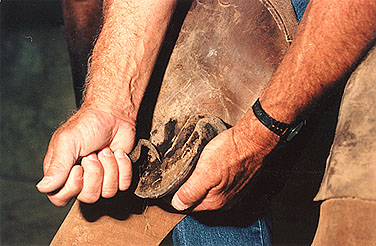 Routine Foot Care Routine Foot Care
Disease organisms concentrate where animals are confined, so cleanliness is
important. Horses kept in a stall or small pen should have their feet picked
or cleaned daily to reduce the risk of thrush. Thrush is the condition
resulting from bacterial penetration into the frog and surrounding area. The
bacteria produce a foul odor and cause the frog to become soft and mushy. If
allowed to go untreated, serious lameness can result and extensive treatment
will be necessary.
Routine daily foot care means regular use of the hoof pick to clean the
horse's feet. A fine-bristled wire brush also is useful for cleaning the
sole, frog and hoof wall. Take care not to damage the periople with too much
pressure from the wire brush; the result would disturb the moisture balance
of the foot.
Foot Cleaning
When picking the foot, use a hoof pick and clean from the heel toward the
toe, being especially careful to clean the commissures on each side of the
frog and the cleft of the frog itself (Figure 3). Don't attempt to open the
heel excessively, as this weakens the area and interferes with proper
contraction and expansion of the heel.
After riding, clean the sole and check for gravel or other foreign
objects that could be lodged in the natural depressions of the foot. A nail,
gravel, stick or other object can work into the foot and cause lameness of
long duration. Objects have been known to exist in a horse's foot for as
long as a year before emerging at the heel or along the coronet. When a
foreign particle emerges at the coronary area, a sore, called a quittor,
usually develops. This problem can easily lead to serious infection.
Maintain Moisture in Feet
Moisture in the horse's feet helps to maintain flexibility and prevent
cracking. Most of the moisture needed in a healthy and well-protected foot
can come from within.
Extremely wet conditions such as a muddy lot or wet stall promote rapid
drying of the feet; the natural oils and protective films of the foot are
eroded from constant contact with external moisture.
One way to maintain proper moisture in the foot is to regularly apply a
good hoof dressing containing some animal fat such as lanolin. If the
dressing is not a petroleum derivative, it can be massaged into the coronet,
the frog and the sole as well as on the hoof wall. The dressing helps to
keep the sole pliable and eliminate dead tissue around the frog and heel.
Also, massaging the coronet stimulates growth of a healthy new hoof wall.
Trimming Maintains Foot Balance
Trimming of feet is important, although not needed as frequently as
cleaning. Trimming should be done at about four-week intervals on horses
kept in stalls or paddocks, or about six-week intervals for horses used
heavily or running in pastures.
The main goal in trimming is to retain the proper shape and length of the
foot. Most people should feel comfortable in pulling shoes and trimming feet
while they wait for the farrier.
The bottom of the foot should be kept level and the inside and outside
walls should be maintained at equal lengths.
The hoof wall should be trimmed with nippers to remove excess length (see
figure 4), then a rasp should be used to smooth and level the bottom of the
foot. Be sure to rasp from the heel through the toe with each stroke to
prevent uneven areas in the hoof wall (Figure 5).
|
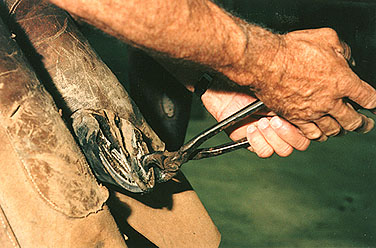
Figure 4. Trim hoof wall with nippers to remove excess length.
|
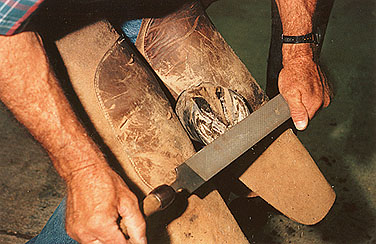
Figure 5. After using the nippers, level the foot by rasping. Be careful
to leave both walls the same length.
|
The white line is external evidence of the lamination (sensitive laminae)
between the hoof wall and the coffin bone. The sole of the foot is usually
of uniform thickness in a normal horse. Because of that, the sole should not
be trimmed to an unnatural shape. To do so would cause parts of the sole to
be dangerously thin and tender.
Trimming the sole, referred to as lowering the sole, is done to keep the
pressure on the hoof wall rather than on the sensitive inner parts of the
foot. The dead, flaky tissue should be trimmed from the sole. Live tissue,
elastic when stretched between the fingers, should not be trimmed away
(Figure 6).
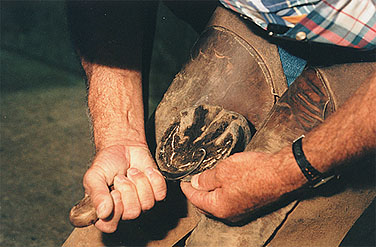
Figure 6. After leveling the hoof, lower the sole so the hoof wall bears
the weight of the horse.
Don't trim the frog excessively; it should contact the ground with each
step. Trim the frog only enough to remove dead tissue and to provide a
uniform and adequate fissure along the junction of the sole and the frog.
After the bearing surface has been rasped to a level surface of proper
length, the edges of the wall should be rounded if the horse will not be
shod. This prevents chipping and peeling as the foot contacts rocks, logs or
other obstructions.
Maintain Hoof Wall Angle
Maintain the proper angle of the hoof wall in relation to the ground and
the angle of the pastern. Shoes that are left on for too long change the
angle of the foot relative to the pastern and can cause lameness. When
possible, the angle of the hoof wall should approximate the angle formed by
the shoulder and the pastern — usually 50 to 54 degrees.
Since the hoof wall is narrower at the heel than at the toe, heels wear
first, whether the horse is barefoot or on shoes. Low heels put more stress
on the tendons of the leg. If a horse is shod at a 50-degree angle, this
angle may change. A 50-degree angle might be down to 46 or 47 degrees in
four to six weeks. This greatly affects the action of the horse and puts
more strain on tendons and ligaments.
As the hoof grows larger, the walls at the heels will overlap the shoe.
When a shoe presses on the bars, there is serious danger of producing corns
in the foot. Running a horse with shoes that have been left on too long also
can cause bowed tendons. Regular trimming and shoe re-setting are essential
in avoiding these problems.
Foot angle varies from breed to breed and much variation is found among
horses of the same breed. Generally, the Western breeds have steeper
pasterns and a greater angle at the ground than the other breeds. Unless
some correction is needed, as in forging and scalping, the foot should be
trimmed to its natural angle, because any change would result in stress in
other areas of the column of bones of the leg.
Trim the heels low enough to promote expansion and prevent contraction of
the heels. The main concern is to trim often enough to prevent cracking and
uneven wear, which could eventually contribute to the improper set of the
feet and legs. With a little practice, most horse owners should be able to
routinely trim feet of horses that do not need corrective work. It is wise,
however, not to take a chance on compounding a problem on horses that need
corrective trimming. To prevent harmful mistakes, seek the help of a
professional farrier when trying to correct an improper turn or set of the
feet and legs.
Founder Brings Feet Problems
Fat horses tend to have problems with laminitis (founder). This is
especially common among horses with some Shetland pony breeding. Grass
founder in the spring produces more laminitis than any other single cause.
If your horse is fat, grazes abundant grass, and is not exercised, there is
great risk of laminitis.
Laminitis commonly causes lameness. Horses with laminitis have extreme
pain and soreness, especially in their front feet. They try to bear weight
on their back legs and lighten the front end as much as possible by carrying
their front feet forward and their back feet up under their bodies. Horses
showing signs of laminitis should have immediate attention from a
veterinarian.
Therapeutic trimming and shoeing may make a horse with laminitis sound
enough for light work and normal reproduction.
Corrective Trimming
The most common deviations from a normal set of feet and legs are toe in
(pigeon toed) and toe out of either front or rear feet. Other problems
commonly corrected by trimming are cocked ankles, buck knees, calf knees,
sickle hocks and slight rotations of the cannon bone. Also, some common
faults in movement of feet in stride — forging, scalping, interfering and
brushing — are corrected by careful trimming.
The most important aspects of good foot care are regularity, frequency,
cleanliness and the use of proper corrective measures.
Handling the Feet
Learning and practicing safe handling of the horse's feet are important
steps in performing routine foot care. Horses should be taught early in life
to yield their feet.
Most horses are worked more from the left side than the right, so begin
working with the left front foot. Rub down the leg toward the foot with your
right hand while your left hand is on the shoulder. Push off with your left
hand if you need to move away.
Squeeze the tendon to get the horse to yield the foot if it won't do so
otherwise. Move the hand in front of the canon or fetlock as the foot
raises. Position the foot firmly between your knees. If the horse struggles
and wishes to regain its foot, let it do so. You can't hold a front foot if
the horse rears. Repeat the procedure until the horse learns to yield its
feet willingly.
To lift a hind foot, keep one hand near the hip and go down the leg
slowly with the other (Figures 7 and 8). Work in close to the horse. Pull
forward on the canon until the horse yields its foot. If you feel tense
muscles, go more slowly. Step promptly under the raised foot with the inside
leg and set the foot above your knees. Lock it in place with your elbow over
the hock and your toes pointed toward each other. Hold the foot in this
position so both hands are free to work.
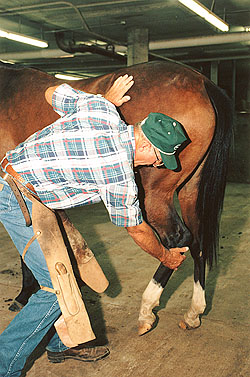
Figure 6. Pick up the hind feet with care. Brace with one hand against
the horse's hip while you work down the leg with the other hand. With
the horse relaxed, lift the foot forward and step under it with your
inside leg.
|
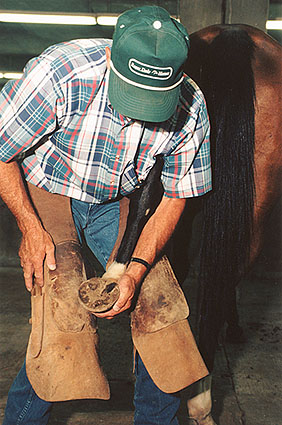
Figure 7. Proper position when holding the hind foot. With the hock
under the arm pit, ankle on knees, and foot backward (upward) the horse
will submit to foot care.
|
For more details in safely handling your horse's legs and feet, refer to
MU publication
G2878, Safe Ground Handling of Horses
LINKS
|